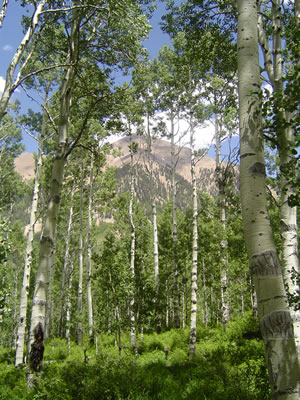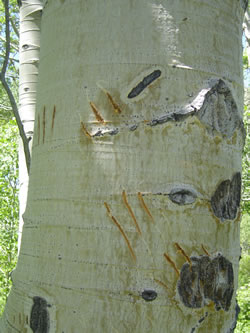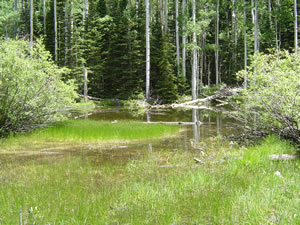 No
billionaire oil sheiks. No movie moguls. No trophy homes,
wives, or sports cars. Unlike Colorado, when you say ‘Aspen’ and ‘Utah’ all
you get is trees in the mountains. To some this might seem
unglamorous and pedestrian, but for my money being a pedestrian
is plenty glamorous, especially when you’re strolling
through a shady glade of stately aspen trees on a summer
afternoon. If you’re intent on hiking Moab in July,
aspen groves certainly rate as one of the more comfortable
options and the nearby La Sal Mountains provide ample opportunity. No
billionaire oil sheiks. No movie moguls. No trophy homes,
wives, or sports cars. Unlike Colorado, when you say ‘Aspen’ and ‘Utah’ all
you get is trees in the mountains. To some this might seem
unglamorous and pedestrian, but for my money being a pedestrian
is plenty glamorous, especially when you’re strolling
through a shady glade of stately aspen trees on a summer
afternoon. If you’re intent on hiking Moab in July,
aspen groves certainly rate as one of the more comfortable
options and the nearby La Sal Mountains provide ample opportunity.
There is, of course, a sameness to aspen groves anywhere
in the west. It doesn’t matter much if you’re in Utah, Colorado, New Mexico,
or Wyoming, once you’re in the trees it’s going to look and
feel much like any other aspen colony. That’s a good thing. Along
with the cool shade, the stately white boles and shimmering green canopy
of an aspen grove provide a sense of nobility that few other forests
match. It’s as if you were in a giant monument to some Greek god
or great person; Nature’s equivalent of the Parthenon or Lincoln
Memorial. Simply strolling through the airy esplanade and its knee-deep
carpet of lush green might be satisfying enough, but knowing a little
bit about this fantastic ecosystem enhances the experience.
Perhaps the most interesting thing about aspens is that each grove is
actually a single organism, a clone. When a hillside becomes available
for colonization a single tree will send roots and runners across the
entire available area. This is why all the trees in one grove are nearly
identical in size. They are sisters of an age and acting as a single
organism. In the spring, each grove leafs out at a slightly different
time than its neighbors. In the fall, each turns color as a unit. As
the grove matures and dies, all its members give up the ghost collectively.
The largest organism in the world is considered to be an aspen grove
in Utah’s Wasatch Mountains.
Another interesting aspect to aspens is the scarring on their trunks.
The distinctive eye-shaped formations the cover the boles are the result
of a self-pruning strategy. As the trees grow and the canopy ascends,
each tree cuts off the sap to the lower branches. As those branches atrophy
and fall off, they leave these distinctive scars. I’m not usually
prone to anthropomorphism, but in an aspen grove it’s almost unavoidable.
When I walk among the aspens I frequently get a feeling that the forest
is a sentient being, watching me through its aspen eyes. Woo-ooo-oo!
Spooky.
 Aspen
bark is very sensitive and, once scored, it holds the mark for the life
of the tree. Elk will eat the bark of the trees, especially during some
leaner moments of the winter, leaving vertical score-marks three to six
inches long about four or five feet above the ground. A more subtle mark
to look for is that of the bear claws. There are a lot of bears, the
mostly harmless black variety, in the La Sals. When a bear climbs an
aspen its claws sink into the soft bark and you can actually track the
bear’s ascent by these distinctive marks. Aspen
bark is very sensitive and, once scored, it holds the mark for the life
of the tree. Elk will eat the bark of the trees, especially during some
leaner moments of the winter, leaving vertical score-marks three to six
inches long about four or five feet above the ground. A more subtle mark
to look for is that of the bear claws. There are a lot of bears, the
mostly harmless black variety, in the La Sals. When a bear climbs an
aspen its claws sink into the soft bark and you can actually track the
bear’s ascent by these distinctive marks.
The last scarring phenomena to look for are dendroglyphs. Dendroglyph
is a high-falutin’ way of saying ‘carving on the bark’.
The aspens in the La Sals are full of these carvings. The oldest ones
go back a hundred years to the cowboys and shepherds who ran their herds
and flocks in the La Sals every summer. Later, but still before air-conditioning,
many Moab families would spend large parts of the summer retreating to
the mesas and green glades that skirt the mountains. There are numerous
memorials to young love, memorable excursions, and risqué ribaldry.
The temptation to carve into aspen bark is strong and there are fresh
dendroglyphs every year. While I don’t condone the practice (aspen
trees are prone to fungal infection and any breach of the bark is potentially
dangerous to the individual and organism), I certainly understand the
impulse. In fact, as an avid reader, I even welcome the occasional literary
diversion.
 Warner
Lake Warner
Lake
It takes about an hour to drive on the La Sal Loop Road to Warner Lake
and it includes a gain in elevation of almost a mile. This gain translates
into a loss of ten to fifteen degrees which, combined with the relaxing
green of the forest, can be quite a relief. This is an easy walk, especially
if you stroll past the lake and up the Wet Fork of Mill Creek. The trail
follows this stream to Burro Pass, about five miles up the trail (don’t
believe the sign). This is a particularly lovely and soothing excursion.
If you make it as far as the pass you get a great view of the Uncompahgre
Plateau to the east. There is also an option to take the Dry Fork Trail.
It’s not nearly so relaxing and is brutally steep near the summit
Oowah Lake
The turn off for Oowah Lake is also on the Loop Road, but you don’t
climb as much in your car as you do when driving to Warner Lake. This
means that you’ll be climbing on foot and the first mile of the
trail is quite steep. I suggest going to the left, taking the trail about
two miles to Clark Lake, then looping around to the right to complete
a nice circuit. A more intrepid party with more time on its hands might
continue up the canyon from Clark Lake to Moonlight Meadows and Geyser
Pass, which is quite a lovely area if the cows haven’t trampled
it yet.
Geyser Pass Road
You also reach the Geyser Pass Road (named for a guy called Geyser, not
a thermal phenomena) from the Loop Road. About four miles past the
intersection it meets the Trans LaSal Trail. You can take this trail
north to Oowah Lake. There is a delightful little spur just before
you begin the climb to Boren Mesa that is well worth exploring. Or,
you can take the trail south towards Pole Canyon. This path is a little
more demanding and offers more of a variation between aspens and firs.
Either option crosses some lovely, tumbling mountain streams in fairly
short order.
Rory Tyler leads
custom rock art tours and backcountry hikes for people
of all skill levels for Canyon Voyages Adventure Company.
Cryptos (krip’ tose): The surface of Moab’s desert is held together
by a thin skin of living organisms known as cryptobiotic
soil or cryptos. It has a lumpy black appearance,
is very fragile, and takes decades to heal when
it has been damaged. This soil is a critical
part of the survival of the desert. The cryptobiotic
organisms help to stabilize the soil, hold moisture,
and provide protection for germination of the
seeds of other plants.
Without
it the dry areas of the west would be much
different. Although some disturbance is normal
and helps the soil to capture moisture, excessive
disturbance by hooves, bicycle tires and hiking
boots has been shown to destroy the cryptobiotic
organisms and their contribution to the soil.
When you walk around Moab avoid crushing the
cryptos. Stay on trails, walk in washes, hop
from stone to stone.
Whatever
it takes, don’t crunch the cryptos unless
you absolutely have to! |
|